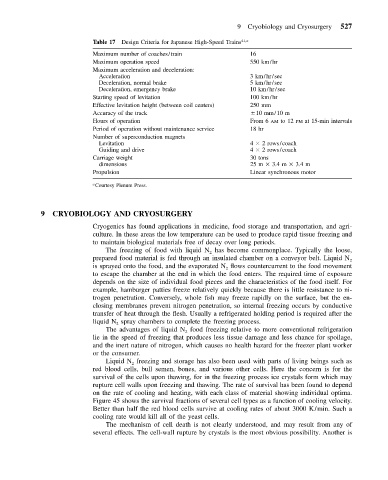Page 538 - Mechanical Engineers' Handbook (Volume 4)
P. 538
9 Cryobiology and Cryosurgery 527
Table 17 Design Criteria for Japanese High-Speed Trains 41,a
Maximum number of coaches/train 16
Maximum operation speed 550 km/hr
Maximum acceleration and deceleration:
Acceleration 3 km/hr/sec
Deceleration, normal brake 5 km/hr/sec
Deceleration, emergency brake 10 km/hr/sec
Starting speed of levitation 100 km/hr
Effective levitation height (between coil centers) 250 mm
Accuracy of the track 10 mm/10 m
Hours of operation From 6 AM to 12 PM at 15-min intervals
Period of operation without maintenance service 18 hr
Number of superconduction magnets
Levitation 4 2 rows/coach
Guiding and drive 4 2 rows/coach
Carriage weight 30 tons
dimensions 25 m 3.4 m 3.4 m
Propulsion Linear synchronous motor
a Courtesy Plenum Press.
9 CRYOBIOLOGY AND CRYOSURGERY
Cryogenics has found applications in medicine, food storage and transportation, and agri-
culture. In these areas the low temperature can be used to produce rapid tissue freezing and
to maintain biological materials free of decay over long periods.
The freezing of food with liquid N has become commonplace. Typically the loose,
2
prepared food material is fed through an insulated chamber on a conveyor belt. Liquid N 2
is sprayed onto the food, and the evaporated N flows countercurrent to the food movement
2
to escape the chamber at the end in which the food enters. The required time of exposure
depends on the size of individual food pieces and the characteristics of the food itself. For
example, hamburger patties freeze relatively quickly because there is little resistance to ni-
trogen penetration. Conversely, whole fish may freeze rapidly on the surface, but the en-
closing membranes prevent nitrogen penetration, so internal freezing occurs by conductive
transfer of heat through the flesh. Usually a refrigerated holding period is required after the
liquid N spray chambers to complete the freezing process.
2
The advantages of liquid N food freezing relative to more conventional refrigeration
2
lie in the speed of freezing that produces less tissue damage and less chance for spoilage,
and the inert nature of nitrogen, which causes no health hazard for the freezer plant worker
or the consumer.
Liquid N freezing and storage has also been used with parts of living beings such as
2
red blood cells, bull semen, bones, and various other cells. Here the concern is for the
survival of the cells upon thawing, for in the freezing process ice crystals form which may
rupture cell walls upon freezing and thawing. The rate of survival has been found to depend
on the rate of cooling and heating, with each class of material showing individual optima.
Figure 45 shows the survival fractions of several cell types as a function of cooling velocity.
Better than half the red blood cells survive at cooling rates of about 3000 K/min. Such a
cooling rate would kill all of the yeast cells.
The mechanism of cell death is not clearly understood, and may result from any of
several effects. The cell-wall rupture by crystals is the most obvious possibility. Another is

